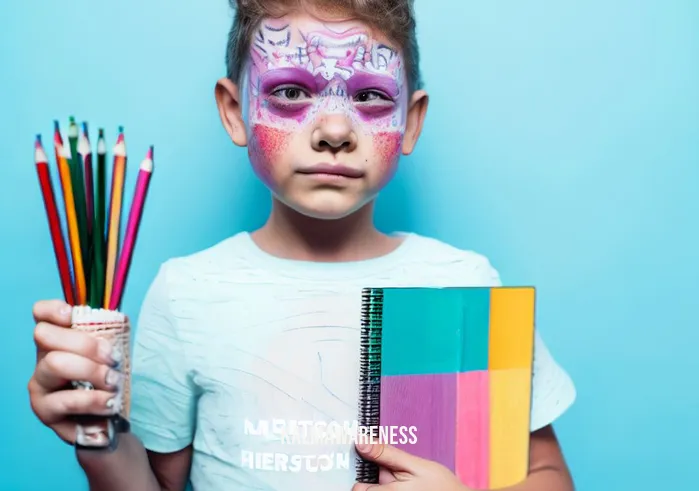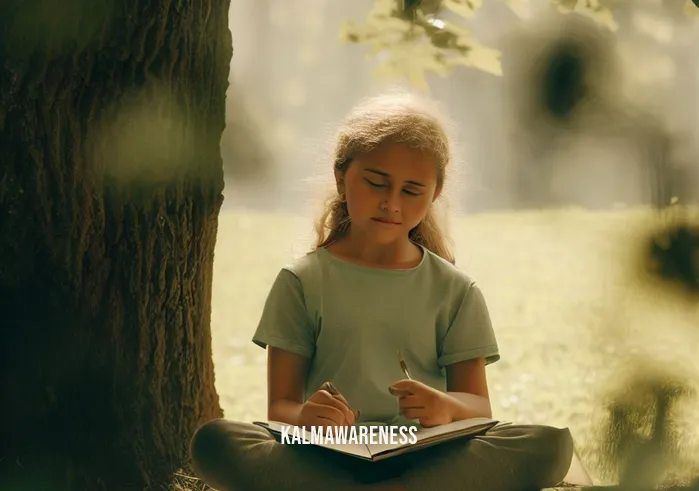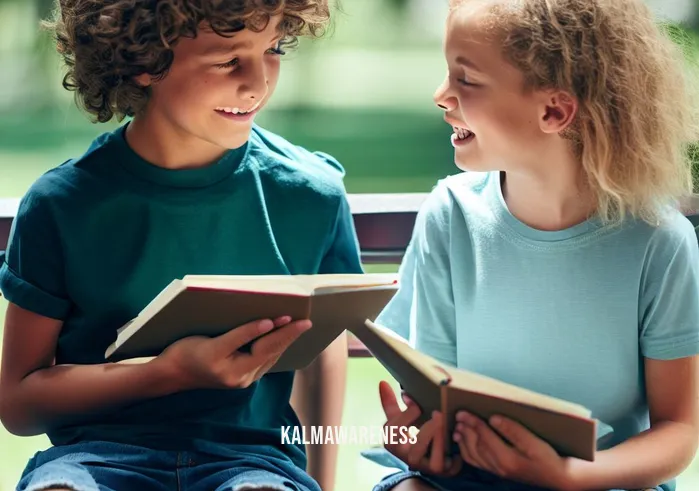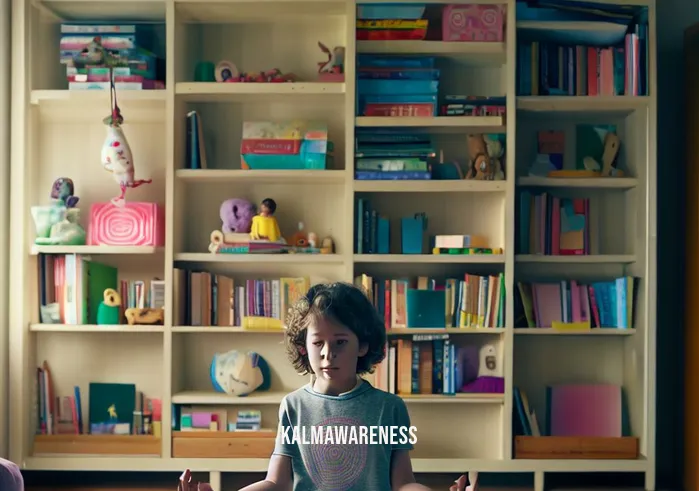The Pioneering Approach of a Mindfulness Journal for Kids
In today’s digital era, where screens often overshadow real-world experiences, the mental well-being of children is at risk. Amidst the chaos and distractions, a simple yet transformative practice has emerged: the mindfulness journal for kids. Through this practice, children are introduced to the world of mindfulness and journaling, equipping them with tools to navigate their emotions, enhance their mental health, and benefit their education. This introductory segment delves into the foundational concepts behind this practice and sets the stage for a more profound exploration in the succeeding segments.
Understanding Mindfulness and Its Relevance
Mindfulness, at its core, is about being present. It’s about anchoring ourselves in the moment, neither dwelling in the past nor anxiously anticipating the future. It’s the very essence of the phrase “life is available only in the present moment“. When we are mindful, we pay attention to our thoughts and feelings without judgment. This practice has roots in ancient African meditation techniques and has evolved over time, incorporating practices such as micromeditating and meditation in motion.
For children, mindfulness helps in several ways. It fosters self-awareness, aids in the understanding of emotions, and provides a buffer against the stresses of growing up. Imagine the empowerment a child feels when they can recognize and regulate their feelings, or the peace they experience when engaging in meditation stories for students.
The Power of Journaling
Journaling, when combined with mindfulness, becomes a potent tool. It isn’t merely about chronicling daily events but reflecting on experiences, feelings, and thoughts. Journaling helps kids articulate their emotions, making sense of what they feel and why. By maintaining a daily or weekly journal, children develop a practice of introspection, fostering an understanding of their habitual thinking patterns.
The act of writing in a journal also aligns closely with educational benefits. It enhances writing skills, encourages creativity, and provides an avenue for self-expression. Furthermore, it’s worth noting that kids who journal are also engaging in an act of self-care, a practice that’s essential for mental health.
Why Combine Both?
The amalgamation of mindfulness and journaling in the context of a mindfulness journal for kids is no accident. The combination allows children to experience the present moment vividly and then articulate that experience, translating ephemeral thoughts and emotions into tangible words. It’s like capturing a moment of clarity or a burst of emotion and preserving it for introspection.
Through this process, children can learn invaluable skills. They can grasp concepts like gratitude, as seen in practices like gratitude yoga in Princeton. They can also embrace techniques from mindful martial arts to harness their energy positively. By making mindfulness an active and reflective practice, the journal becomes a cherished guide for their journey.
Setting the Stage for Further Exploration
In the upcoming segments, we will dive deeper into how to structure a mindfulness journal for kids, exploring techniques, activities, and exercises tailored for them. We’ll delve into resources, from mindfulness books for teens to ways to inculcate practices such as mindful hiking. By the end of our journey, parents, educators, and even children themselves will be equipped with a blueprint to nurture mindfulness, ensuring a healthier, more balanced approach to life and learning.
The world of mindfulness and journaling offers endless possibilities for growth, self-awareness, and healing. The journey may start with a simple journal entry, but its impact resonates through a lifetime. Are you ready to dive deeper into this transformative practice? Continue reading and explore the world of mindfulness journaling for kids with us.

Crafting the Perfect Mindfulness Journal for Kids
Having laid the groundwork of understanding the significance of a mindfulness journal for children, we delve deeper into the nuances of crafting such a journal. The meticulous act of journaling, combined with the centeredness of mindfulness, offers a sanctuary of reflection and growth. In this segment, we’ll explore the components that make up an effective mindfulness journal for young minds, the benefits children can derive, and a practical table to guide parents and educators in its implementation.
Components of an Effective Mindfulness Journal
- Prompts for Reflection: Children, especially those new to journaling, benefit immensely from prompts. These lead questions encourage them to reflect on their day, emotions, and interactions.
- Space for Free Writing: It’s crucial to have an area where children can freely express their thoughts without any guiding questions.
- Gratitude Section: As taught in practices like mindful skills, expressing gratitude daily can shape a positive mindset.
- Daily Affirmations: Words hold power. Having kids write or choose an affirmation daily can boost their self-esteem and confidence.
- Illustrations and Doodles: Giving room for artistic expression can be a fun way for kids to represent their feelings and thoughts visually.
- Guided Meditation Logs: As they delve into practices like meditation pleine conscience, a section to reflect on their meditation experiences can be valuable.
Synonymous Benefits of a Mindfulness Diary
- Cognitive Development: As children articulate their thoughts, they develop critical thinking and analytical skills.
- Emotional Regulation: Recognizing and expressing emotions can lead to better emotional management.
- Stress Reduction: The act of writing and practicing mindfulness, much like the teachings from the mindful miracle, serves as a stress reliever.
- Improved Communication: Regular journaling can hone a child’s ability to communicate their feelings and thoughts.
- Enhanced Creativity: Encouraging free writing and artistic illustrations can spark creativity.
Structuring a Mindfulness Journal for Young Minds
| Section Name | Purpose | Examples |
|---|---|---|
| Prompts | Guided reflection | “How did you feel today?”, “What made you laugh?” |
| Free Writing Space | Uninhibited expression | Personal stories, dreams, or anecdotes |
| Gratitude Section | Daily thanks | “I’m thankful for my family because…” |
| Daily Affirmations | Boosting self-worth | “I am brave”, “I am kind” |
| Illustrations | Artistic representation of emotions | Doodles, sketches, color patterns |
| Meditation Logs | Recording meditation experiences | “Mindful en español reflections”, “Today’s breathing exercise…” |
Conclusively, the essence of a mindfulness journal for kids extends beyond the act of writing. It’s a journey of self-discovery, emotional intelligence, and personal growth. The meticulously crafted sections aim to nurture young minds, helping them understand themselves and the world around them better. With each entry, children get one step closer to becoming more mindful, self-aware, and emotionally resilient individuals.
In our next segment, we’ll shift our focus to the hands-on approach. How can parents and educators actively help kids maintain their mindfulness journals? What are the challenges one might face, and how can they be overcome? Stay tuned and continue reading to embark on this enlightening journey with us.

Harnessing Hope: The Inspirational Path of Mindfulness Journals for Kids
The transformative power of a mindfulness journal for children doesn’t just rest in its practice but also in the inspirational stories and moments that it fosters. Throughout this journey, there have been countless tales of children who’ve discovered hope, resilience, and self-belief through their mindfulness journals. These stories serve as a beacon of light for parents and educators, affirming the potential of such journals in changing young lives.
Echoes of Hope: Real-Life Testimonials
Maya’s Transformation: Maya, a 10-year-old with anxiety issues, always found it challenging to communicate her fears. Introduced to mindfulness journaling through her school’s mindful hiking program, she began documenting her emotions, thoughts, and discoveries from each hike. Over time, her entries reflected a shift—from anxiety-riddled notes to expressions of hope, gratitude, and understanding.
Leo’s Reconnection: Distanced from his cultural roots, Leo felt lost amidst his peers. His introduction to the ancient African meditation techniques at a workshop ignited a curiosity. Documenting his feelings, learnings, and ancestral connections in his mindfulness journal, Leo not only found his identity but also inspired many classmates to explore their heritage.
Sophie’s Victory: Sophie faced bullying at school, leading to a dent in her self-esteem. On the advice of a meditation consultant, she started maintaining a mindfulness journal. Through affirmations, reflections, and guided meditations, Sophie built resilience. Her journal became her shield, a testament to her growth, and a source of inspiration for other victims.
Resonating Quotes of Empowerment
- “In the quiet reflection of our journal, we hear the whispers of our soul.” — Unknown
- “The pen is mightier than the mind’s shadows. Write your fears, and you’ll see them diminish.” — L. Thompson
- “Each journal entry is a step towards understanding, and every page turned is a lesson learned.” — M. Brighton
- “Through the lens of mindfulness, every child’s journal becomes a book of hope.” — P. Greenway
- “In moments of doubt, open your journal, and let it remind you of your strength.” — S. Tidwell
The Ripple Effect of Inspiration
While these stories and quotes underscore the transformative power of mindfulness journaling for kids, the real magic lies in the ripple effect they create. Every child who finds solace, strength, and self-belief in their journal becomes a beacon of hope for others. They demonstrate the tangible benefits of maintaining a diary grounded in mindfulness, fostering an environment where mental and emotional well-being is celebrated.
Moreover, for educators and parents, these tales of transformation emphasize the significance of encouraging such practices. It’s not merely about promoting journaling but about providing kids with a tool that aids in self-exploration, healing, and growth.
As we forge ahead, the next chapter promises to delve into the practical aspects. How can we, as mentors, create an environment conducive to mindfulness journaling? What are the tools and resources at our disposal? And most importantly, how can we sustain this practice in the long run, ensuring its benefits permeate every aspect of a child’s life?
Stay with us, as we venture into the hands-on realm of making mindfulness journals a cornerstone of every child’s daily routine. Your guide to creating a brighter, hope-filled future awaits in the next segment. Continue reading to uncover the practical magic of mindfulness journals for our young ones.

Demystifying the Mindfulness Journal for Kids: A Detailed Breakdown
The transformative potential of a mindfulness journal for kids has been a recurrent theme throughout our exploration. Yet, the intricate details and mechanics underlying this potent tool merit a closer look. By breaking down its components and the science behind it, we can foster a more profound appreciation and practical understanding, enabling us to support our children effectively on their journey of mindfulness and self-reflection.
Key Elements of a Successful Mindfulness Journal
Purpose-Driven Structure: Every section of the journal should have a clear intention, from guided prompts to free writing spaces.
Adaptable Layout: The journal should be flexible, allowing children to customize it to their preferences, echoing the principles of mindful martial arts, where adaptability is key.
Inclusive Imagery: Illustrations and graphics should cater to diverse audiences, ensuring every child feels represented and valued.
Space for Growth: As the child matures, the journal should have sections that cater to their evolving emotional and cognitive needs.
Guidance and Resources: Incorporating tips, techniques, or references, like the wisdom from the Penn mindfulness class, can be beneficial.
Science Behind the Success of Mindfulness Journaling
Cognitive Reflection: Writing allows kids to process their thoughts, facilitating better comprehension and problem-solving.
Emotional Catharsis: Articulating feelings provides emotional release, reminiscent of practices in meditation for menopause where articulation aids healing.
Habit Formation: Regular journaling fosters discipline and consistency, traits beneficial in multiple life arenas.
Memory Enhancement: Documenting experiences enhances memory retention, as children revisit and reinforce their learnings.
Empathy Building: Reflecting on personal experiences can make kids more empathetic as they relate to the emotions and situations of others.
Ensuring Continued Engagement
Interactive Sections: Incorporate activities or interactive sections that resonate with practices from meditation in motion.
Visual Stimulants: Vibrant illustrations, stickers, or even DIY art sections can make journaling more engaging.
Periodic Rewards: Recognizing milestones or consistent journaling practices can be a motivation booster.
Incorporation of Technology: Integrating tech elements, perhaps through QR codes linking to mindful miracle exercises, can appeal to the tech-savvy generation.
Feedback Loop: Periodic reviews of the journal entries can help children see their growth, encouraging them to continue.
Why Every Child Needs a Mindfulness Journal
Boosted Self-Awareness: By consistently reflecting, children become more in-tune with their thoughts and emotions.
Enhanced Creativity: Beyond words, the freedom to doodle and illustrate sparks creativity.
Resilience Building: Encountering and overcoming challenges on paper equips children with coping mechanisms for real-life hurdles.
Cultivated Positivity: Practices akin to gratitude yoga Princeton within journaling cultivate positivity and gratitude.
Holistic Development: Addressing both the emotional and cognitive aspects, mindfulness journals foster a well-rounded development.
Embarking on the mindfulness journal journey equips kids with a companion that evolves with them, captures their essence, and aids their growth. With each entry, they’re not just penning down words; they’re chronicling their evolution, one thought, and one emotion at a time.
In our concluding chapter, we’ll encapsulate the essence of our exploration, providing final thoughts, actionable takeaways, and envisioning the future of mindfulness journals for kids. The culmination of our journey promises insights, reflections, and a renewed zeal to make these journals an integral part of every child’s life. Stay with us for the concluding insights in the next chapter.

The Mindfulness Journal Odyssey: Reflections and Forward Strides
Our enlightening journey exploring the intricacies of a mindfulness journal for kids culminates here. We’ve traversed the realms of mindfulness, delved deep into journaling, heard heartwarming tales of transformation, and comprehensively deconstructed the essence of these journals. As we pause to reflect, let’s consolidate our learnings and envision the future.
From Clarity to Application
Mindfulness journals, much like the teachings from mindful muscle, empower children to harness their internal strength and navigate the complex tapestry of emotions, growth, and self-discovery. The symbiotic union of mindfulness and journaling has displayed its transformative power, heralding a brighter path for the younger generation.
Key Takeaways from our Journey:
Personal Growth: The journal fosters introspection, helping kids recognize and articulate their emotions.
Enhanced Cognitive Skills: Regular journaling sharpens analytical and problem-solving abilities.
Emotional Resilience: By confronting challenges on paper, children build robust coping mechanisms.
Celebration of Moments: Through practices reminiscent of a renewed mind employee portal, children learn the art of cherishing the present.
Embarking on Your Personal Mindfulness Quest
For parents and educators who’ve journeyed with us, it’s time to transition from knowledge to action. Here’s how:
Invest in a Journal: Seek a journal that resonates with your child’s personality and needs.
Encourage Regularity: Like the philosophy behind meditation stories for students, consistency is key. Encourage daily or weekly entries.
Engage in Shared Journaling: Bond with your child by maintaining a joint journal, fostering shared experiences and reflections.
Seek Feedback: Periodically discuss the journal’s impact with your child, understanding its benefits and areas of improvement.
Evolve with Time: As your child matures, adapt the journal to reflect their evolving emotional and cognitive needs.
Our Gratitude and an Invitation
To our cherished readers, we express our heartfelt gratitude for joining us on this enlightening voyage. Your engagement and curiosity have made this exploration even more rewarding. While this chapter concludes our series on the mindfulness journal for kids, the broader tapestry of mindfulness has myriad threads left to explore.
We invite you to delve deeper into our content, uncovering gems like mindful hiking or the nuances of mindful en español. Should you wish for a refresher or seek deeper insights into any segment, our prior chapters are always accessible for revisiting.
Rest assured, our commitment to illuminating the world of mindfulness remains unwavering. Await more insightful content in our upcoming editions, promising a blend of knowledge, application, and inspiration.
Here’s to brighter tomorrows, mindful moments, and journals filled with hope and discovery! Embark, reflect, and flourish with the magic of mindfulness.


